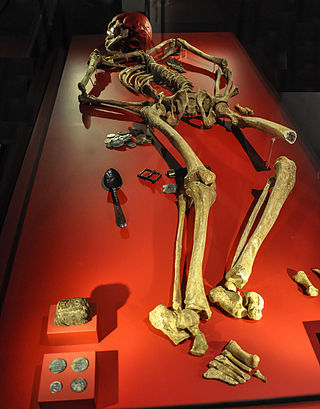
Berthe Marie Pauline Morisot was a French painter and a member of the circle of painters in Paris who became known as the Impressionists.

Panoramic paintings are massive artworks that reveal a wide, all-encompassing view of a particular subject, often a landscape, military battle, or historical event. They became especially popular in the 19th century in Europe and the United States, inciting opposition from some writers of Romantic poetry. A few have survived into the 21st century and are on public display. Typically shown in rotundas for viewing, panoramas were meant to be so lifelike they confused the spectator between what was real and what was image.

Braine-l'Alleud is a municipality of Wallonia, in the province of Walloon Brabant, Belgium, about 20 kilometres south of Brussels.

Waterloo is a municipality in Wallonia, located in the province of Walloon Brabant, Belgium, which in 2011 had a population of 29,706 and an area of 21.03 km2 (8.12 sq mi). Waterloo lies a short distance south of Brussels, and immediately north-east of the larger town of Braine-l'Alleud. It is the site of the Battle of Waterloo, where the resurgent Napoleon was defeated for the final time in 1815. Waterloo lies immediately south of the official language border between Flanders and Wallonia.
A cyclorama is a panoramic image on the inside of a cylindrical platform, designed to give viewers standing in the middle of the cylinder a 360° view, and also a building designed to show a panoramic image. The intended effect is to make viewers, surrounded by the panoramic image, feel as if they were standing in the midst of the place depicted in the image.

The National Basilica of the Sacred Heart is a Catholic minor basilica and parish church in Brussels, Belgium. It is dedicated to the Sacred Heart, inspired by the Basilique du Sacré-Cœur in Paris. Symbolically, King Leopold II laid the first stone in 1905 during the celebrations of the 75th anniversary of Belgian independence. The construction was halted by the two world wars and finished only in 1970. Belonging to the Metropolitan Archdiocese of Mechelen–Brussels, it is the 14th largest church by area in the world and the largest in Belgium.

Brussels Cemetery is a cemetery belonging to the City of Brussels in Brussels, Belgium. Located in the neighbouring municipality of Evere, rather than in the City of Brussels proper, it is adjacent to Schaerbeek Cemetery and Evere Cemetery, but should not be confused with either.

The Town Hall of the City of Brussels is a landmark building and the seat of the City of Brussels municipality of Brussels, Belgium. It is located on the south side of the famous Grand-Place/Grote Markt, opposite the neo-Gothic King's House or Bread House building, housing the Brussels City Museum.

The Lion's Mound is a large conical artificial hill in the municipality of Braine-l'Alleud, Walloon Brabant, Belgium. King William I of the Netherlands ordered its construction in 1820, and it was completed in 1826. It commemorates the spot on the battlefield of Waterloo where the king's elder son, Prince William of Orange, is presumed to have been wounded on 18 June 1815, as well as the Battle of Quatre Bras, which had been fought two days earlier.

Werner Tübke was a German painter, best known for his monumental Peasants' War Panorama located in Bad Frankenhausen. Associated with the Leipzig School, he is "one of the few East German artists who gained recognition in West Germany."

Henri Félix Emmanuel Philippoteaux was a French artist and illustrator, known primarily as a battle painter.
A panoramic painting captures all 360 degrees of a scene, as viewed from inside the center of the circle. Typically shown in rotundas for viewing, Romantic Era panoramas were intended to be so lifelike that the viewer became confused as to what was real and what was image.

Jean-Charles Langlois, known as The Colonel was a French soldier and painter.

The Galerie Vivienne is one of the covered passages of Paris, located in the 2nd arrondissement. It is 176 metres (577 ft) long and 3 metres (9.8 ft) wide. The gallery has been registered as a historical monument since 7 July 1974.

The Meeting of Wellington and Blücher after the Battle of Waterloo is a monumental wall painting by Irish painter Daniel Maclise, completed in 1861. It depicts the moment towards the end of the Battle of Waterloo on 18 June 1815, when the commanders of the allied British and Prussian armies, the Duke of Wellington and Marshal Blücher, met near La Belle Alliance. Measuring 3.68 by 13.92 metres, it is displayed in the Royal Gallery at the Palace of Westminster.

The Gordon Monument is a neoclassical monument to a slain warrior on the battlefield of Waterloo. The person commemorated is Lt Colonel Sir Alexander Gordon (1786–1815). It was erected in 1817 by the siblings of the deceased who included a future Prime Minister, Lord Aberdeen.

The Waterloo 1815 Memorial is a Belgian museum complex located on the site of the Waterloo battlefield in Belgium. It includes a museum inaugurated in 2015, the Lion's Mound, the Panorama of the Battle of Waterloo and the Hougoumont farm.

The Waterloo Soldier is the skeleton of a soldier who died during the Battle of Waterloo on 18 June 1815. The skeleton is kept at the Memorial of Waterloo 1815.

The Bourbaki Panorama is a circular panoramic painting depicting the internment of the French Armée de l'Est in neutral Switzerland at the end of the 1870–71 Franco-Prussian War. The army, led by General Charles-Denis Bourbaki, had been defeated in the field while attempting to raise the Siege of Belfort and fled to Switzerland in the aftermath. The Swiss admitted the French soldiers, and local villagers and the Swiss Red Cross provided aid.





















